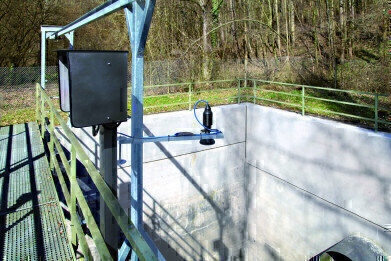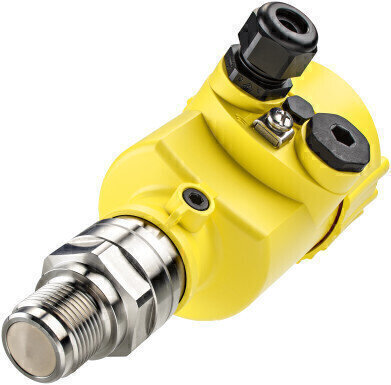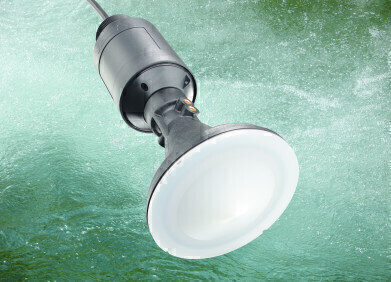-
 The wastewater industry cannot do without reliable level measurement technology.
The wastewater industry cannot do without reliable level measurement technology. -
 Radar measurement technology is gradually replacing ultrasonic measurement technology in the wastewater industry. The picture shows the VEGAPULS 64, which has proven to be a real problem solver thanks to its high frequency.
Radar measurement technology is gradually replacing ultrasonic measurement technology in the wastewater industry. The picture shows the VEGAPULS 64, which has proven to be a real problem solver thanks to its high frequency. -
 The radar sensor VEGAPULS WL 61 opened the door to radar measurement technology in the industry because it is not only robust, but also within the right price point.
The radar sensor VEGAPULS WL 61 opened the door to radar measurement technology in the industry because it is not only robust, but also within the right price point.
Water/Wastewater
Technology change in the wastewater industry: Radar technology replaces ultrasonics
Feb 13 2019
For more than 30 years, ultrasonic was the state-of-the-art technology in the wastewater industry because the technology offered sufficient performance at a reasonable price. Radar sensors were only used where they offered significant application advantages. This has changed over time: Radar technology is not only increasingly becoming a problem solver, but also an all-rounder in the industry.
Level sensors are used in many places in the wastewater industry, both in municipal and industrial wastewater plants. Ultrasonic measurement technology measures level at a reasonable cost, and this is why it’s so widely used. However, there are physical limits to the measuring method. Since the signal propagation time of sound waves depends on the temperature, a temperature sensor must be integrated into the transducer. The sensor determines the current ambient temperature and compensates for the change in the speed of sound. In underground rainwater basins and away from any outside elements, ultrasonics can achieve sufficient accuracy. In open basins, however, the sensors are often heated through exposure to the sun. This leads to incorrect compensation of the sound propagation time and as a result, measurement errors. In chemical plants, a wide variety of chemicals often have high gas concentrations in the air space above the liquid, which alters the sound propagation time of ultrasonic sensors or even absorb sound waves. The minimum measureable distance for ultrasonic sensors is usually between 10 and 50 cm. This additional space between the sensor and the 100% point must be taken into account when installing an ultrasonic device.
Advantages of radar sensors
The switch to radar technology was obvious. However, until a few years ago radar technology still had the reputation of being cost-prohibitive for general use in the wastewater sector. This has changed significantly in recent years. Radar sensors today are comparable in price to ultrasonic sensors – with significantly better performance.
Since the running time of the radar signal in typical applications is influenced neither by temperature nor by rain, wind, or fog, there are clear advantages from an environmental perspective alone. The sensor’s +/- 2 mm high accuracy is not reduced by external influences. Radars don’t have a blocking distance like ultrasonic sensors, so radars work much better in closed basins or other locations without a lot of space between the mounting position and the 100% point. Radar sensors can still operate with the presence of condensate, dirt, or some foam on the water surface better than the previously used ultrasonic devices. There are practically no disadvantages.
Adaptation to practice
A sensor can have all the technological advantages, but it also needs to be practical and durable. VEGA has adapted radar sensors to the conditions prevailing in the water and wastewater industry. For example, housings are made of highly resistant plastic and a permanently connected cable with a high degree of protection IP 68 (2 bar). These options are standard with the VEGAPULS WL 61 from VEGA, giving it a significant advantage over the previously used ultrasonic sensors. This radar sensor always measures the exact level regardless of ambient conditions like temperature fluctuations, sunlight, rain, snowfall, or fog. The VEGAPULS WL 61 is particularly suitable for continuous level measurement in water treatment, pump stations, and rain overflow basins.
With the development of the 80 GHz radar level measurement sensor, VEGAPULS 64, in 2016, the cards are getting shuffled again. Thanks to its better focusing, this device offers an interesting alternative in applications that are considered particularly difficult to measure. An example from the wastewater sector is the particularly narrow wastewater shafts with multiple installations on the wall. Due to the higher frequency, significantly better focusing is possible. This provides the user with stable measured values without the need for labour-intensive fine tuning.
In recent years, radar technology has established itself as an interesting alternative to ultrasonic technology in the wastewater industry.
Digital Edition
IET 34.2 March 2024
April 2024
Gas Detection - Biogas batch fermentation system for laboratory use with automatic gas analysis in real time Water/Wastewater - Upcycling sensors for sustainable nature management - Prist...
View all digital editions
Events
Apr 22 2024 Hannover, Germany
Apr 22 2024 Marrakech, Morroco
Apr 23 2024 Kuala Lumpur, Malaysia
Apr 23 2024 Kintex, South Korea
Apr 23 2024 Edmonton, AB, Canada

















